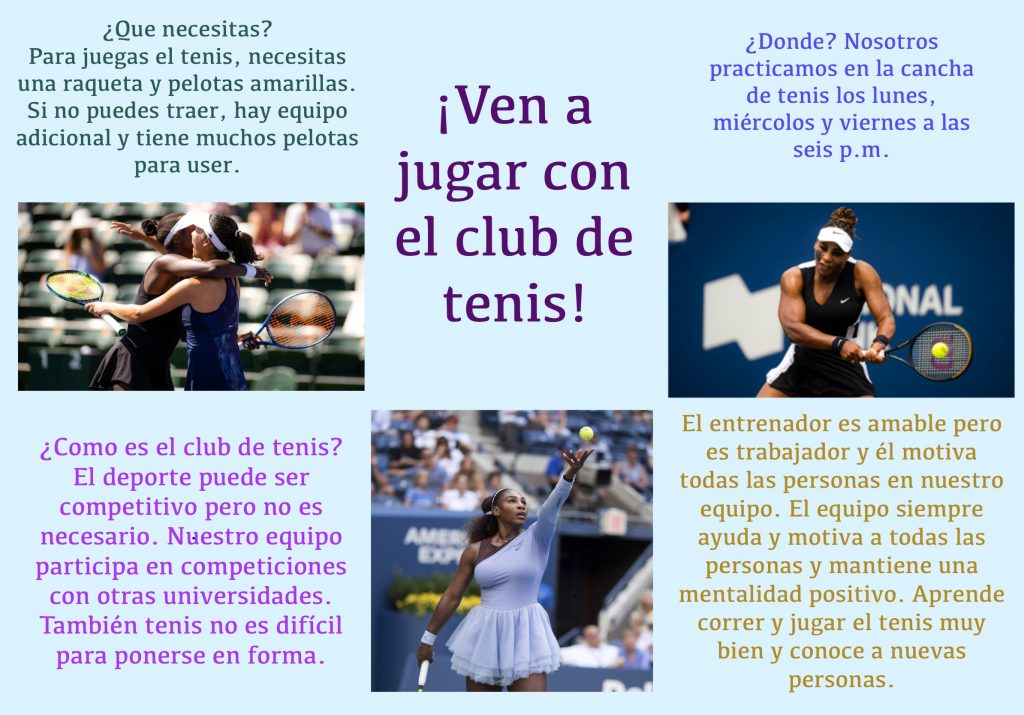Interpretive, Interpersonal, and Presentational Modes of Communication
Spanish 102 was undoubtedly challenging, and forced me to apply myself even more to the culture and language. There was loads of vocabulary that had to be memorized, and the grammar required focus and practice. I have always struggled with grammar, but found that by practicing conversations, my thinking became quicker and I spoke more fluidly.

This project required me to learn the formal command conjugation, and use this knowledge to create an infographic to inform students about the tennis club using relevant vocabulary
Exploring Culture
Listing to the Spanish around me, my ear was able to receive and decipher the words I was hearing, making it easier to understand and translate, and be able to grasp the meaning of their words. However, I come across Spanish speakers who use different vocabulary than what I was taught, so there still is a gap between what I have learned and using it in the real world, but the only way to learn these words is to engage with those using a slightly different vocabulary. I often practice spanish with my fluent coworker, who even encourages me to practice with customers.

Engaging in Communities
I still struggle with engaging in the Spanish speaking community, as I feel that when it comes to impromptu speaking, I blank and forget what I want to say, even though I know what I am trying to express. I do see and appreciate the value of engaging in these communities and learning their culture, as the language is very influenced by those aspects. By engaging in these communities I can improve my Spanish and enjoy the values their culture has.
Interpersonal Communication
TalkAbroad is an assignment which uses a platform to connect language students to native speakers for real world application of the language. During the Spanish 102 course, I had to do two TalkAbroad assignments. One was on “La Familia” and the other was on ”La Comido o La Buena Salud”. These assignments where challenging, but insightful to see my progress of speaking the language and seeing where I need work and improve on. Other ways I have used interpersonal communication with Spanish is at my work place. There is often Spanish speakers who come in, and while I cannot express what I want to say, I am improving on my listening, understanding, and responding with what I do know how to say.
My TalkAbroad audio can be found here.
Presentational Speaking
This class recquired presentational speaking about a variety of topics. Some projects were recorded videos of me presenting my information, while others had to be presented in a group of students. Overall, I enjoyed these assignments as I could prepare for them well. The hardest part about presenting is when I use English filler words instead of Spanish, but this is something I want to work on improving.
The linked video is a presentation about my familia, going into details about what they look like, how their personalities are, and how they are related to me.
Presentational Writing
Most projects and in class practice used speaking, but also heavily relied on being able to write proper sentences in Spanish in order to prepare for the final assignment. For example, writing a proper paragraph in Spanish as a script for a presentational video project.
As my knowledge of Spanish has grown, I found it easier to write down my thoughts and use this knowledge to prepare for this projects and even my TalkAbroad assignments, so that when I forgot what to say, I can refer to my writings to help remind me. Grammar has always been the most difficult part, but keeping up with vocabulary has been key to making sure I can correctly articulate my thoughts into my work.
For a presentational writing assignment, I made a powerpoint discussing anxiety and how to prevent it. This can be found here.
Interpretive Listening
Most of the class required interpretive listening and repeating in order to understand what is being said and being able to respond appropriately. This can be difficult at times, depending on the speed and enunciation of the speaker. This requires more practice of ”thinking in Spanish” so that I spend less time translating and more understanding the language.
Listening is still a challenge for me. I can understand for the most part what is being said, but I need to think quicker and understand the message better overall. I think I need to practice more and handle more situations where I have to listen as that is the best way to learn. Below is a video from Spring Spanish, which tests one’s Spanish skills by explaining a personal story and testing the comprehension at the end. To be honest, I would understood a lot less if I did not have the Spanish subtitles, so there is definitely more room that I can improve on.
Interpretive Reading
There was never a shortage of activities that required reading and comprehending the words in Spanish. Usually, reading is easier for me, as talking takes much more time for me to think on what I have to say. For example, and activity from our Contraseña textbook looked at infographics explaining types of illnesses, how to care for them, and how to prevent them. In order for this infographic to be useful, I have to be able to understand it. The hardest part was learning the new types of conjugations, but after learning them, it as not much more difficult to read.
